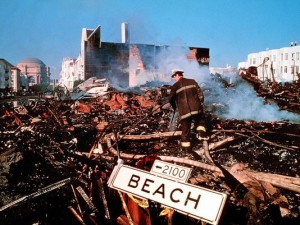Asheville Citizen-Times 2/24/2015 – Ted Alexander, Columnist –

In this photo from Oct. 18, 1989, a San Francisco firefighter looks for hotspots in the Marina District in San Francisco, the morning after the Loma Prieta quake.(Photo: Nick Lammers/Hayward Daily Review/AP) (Photo: Nick Lammers/Hayward Daily Review/AP)
Just as we were approaching the San Francisco International Airport, the captain spoke over the public address system. He mentioned “activity below” and suggested that we look out the left windows. I noticed linear puffs of tan smoke on the ground, then quickly learned I was on the last aircraft of the day to land in the crisis zone — the 7.1 earthquake of 1989, a magnitude not experienced in the area since 1907.
Once on the ground, passengers were advised to disembark the jet by stairs. Our luggage was driven 50 yards to a cyclone security fence outside the gate.
As they stood next to the aircraft, I heard the pilot say to a flight attendant, “We’re cleared to head back to LA. Let’s get out of here.”
I approached them as they were about to board again. “How about letting me go back with you? This is an emergency situation.”
“Sorry, can’t do it. Against regulations.”
They took off.
Electrical power was down and no one was allowed inside the terminals. Hundreds of people moved around outside while others sat on their suitcases and stared blankly ahead.
A lone military helicopter circled the airport.
It was beginning to grow dark, and with no definitive direction offered by authorities, and no hotels in sight, I teamed up with a hospital administrator from Tacoma I’d been talking with. We decided to take action and head into the city.
After walking away from the crowd, I flagged down a metropolitan bus. The driver was generous and let us board though we weren’t at a bus stop.
He dropped us off in a pitch-black San Francisco. We headed for a hotel on Stockton Street, walking through complete darkness — no street lights, no traffic lights, no building lights. I was unable to see anything 5 yards in front of me. People appeared out of the darkness like ghosts, then quickly swept past. The streets could easily have turned into a breeding ground for crime.
The hotel lobby was dimly lit, using power from emergency generators. It was crowded with people talking in hushed tones. Some were crying. Empty paper cups and crumpled candy bar wrappers littered side tables. The overhead lighting repeatedly brightened and dimmed creating an eerie atmosphere.
Smoke from marina fires wafted through the lobby. Aftershocks made the floor feel like it was rolling — as if I was surfing a small wave on a concrete board.
With the smoke, erratic lighting and crush of people, I might have been at a nearly silent, surreal rock concert.
Occasionally someone would scream when an aftershock was particularly intense. And no one knew if the earthquake was over or if the aftershocks were simply the prelude to further destruction.
I sipped lukewarm coffee as I sat on the floor, my back against the wall.
I tried to appear calm amid the raw tension that permeated the lobby.
But I wasn’t.
I knew I should call home. 1989 was before widespread cellular phone usage, and the one public land-line still functioning had more than 50 people waiting to make a call. Those ahead of me on the phone line had broken down once they reached loved ones — tears of joy, tears of fatigue, tears for being alive.
A doorman standing next to the phone enforced a strict 30-second time limit once connected. I waited for over an hour and then gave my home number to the operator who was manually placing each call.
My wife was relieved. I was too. Sort of. I was still stuck in the hit zone.
Later, I sat outside in the dark of the hotel’s fenced-in patio, protected by armed guards at the entrances. In the distance I could hear glass breaking as buildings shifted.
I felt completely vulnerable and isolated. Guards could stop an intruder, but they sure wouldn’t be able to rein in another earthquake or prevent a gas explosion.
Fortunately, despite the endless possibilities, nothing more happened.
I got out of San Francisco the next afternoon, traveled to Los Angeles and stayed the night. The following morning I headed directly home. When the flight attendants heard I had been in the earthquake, they tried to drown me in complimentary cocktails.
I didn’t go to work that day, but instead spent an hour in a vintage toy store. I looked at toys from my childhood: an old Davy Crockett hat, a Schwinn Jaguar bicycle, a retro blow mold Santa Claus that glowed in the dark.
I realize now that I was looking for comfort and security. I had been more shaken up than I originally thought.
The first night home I awoke at midnight certain I had just felt an aftershock. Two nights later, the same experience.
I hadn’t, and after a week or two the thoughts subsided.
But then I asked myself, what did it all mean?
Much has been written about these types of experiences and everyone must reach their own personal truth. Mine was a slight variation on a common theme and quite simple: Life’s a magical mystery tour and I could unexpectedly fall off the rails and into the weeds at any given time.
So the heck with seize the day. Seize the instant, or better yet, never let it loose in the first place.
And yes, a little luck never hurts.
Ted Alexander lives in Asheville. His first novel, “The Fall of Summer,” a 1960s coming-of-age story, is now on sale at Malaprop’s Bookstore/Cafe and other online and local retailers. Contact him at tedmalexander@gmail.com.
Learn more about the author and the novel online at http://tedmalexander.com/Books.html.